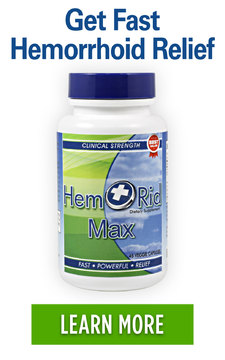The 4 Different Types of Hemorrhoids and What You Must Know About Each One
Posted on 10 May 2018 by Maryanne Johnson
Share this post
Hemorrhoids may be one of the most common problems when it comes to your lower region, so common that half of every grown adult has or will experience hemorrhoid symptoms by age 50.
Table of Contents [hide]
If you have experienced hemorrhoids, you are probably familiar with all of the symptoms that go along with them, but did you know there is more than one type of hemorrhoid?
Hemorrhoids occur when the veins become irritated and begin to swell, usually because of things like constipation or lack of fiber in the diet, and sometimes just because you grow older are more susceptible to getting hemorrhoids.
Hemorrhoids form either inside the rectal area or outside around the anal opening.
These veins lie beneath the mucous membrane inside of the rectum and underneath the skin by your anal sphincter.
If these veins swell and bring on the symptoms of hemorrhoids, their location, either inside the rectum or outside the anal opening, will determine which type of hemorrhoids you have.
The two types are known simply as internal and external hemorrhoids.
Types of Internal Hemorrhoids
Internal hemorrhoids are located inside of the rectal area and are essentially veins that push your blood vessels along to this region.
Internal hemorrhoids become swollen when there is more than a normal amount of pressure and strain placed upon them.
These veins become swollen and irritated, and sometimes, a hardened stool will pass and scrape against them.
This results in rectal bleeding.
If you have ever experienced rectal bleeding, either noticing it covering a stool or on the toilet paper after wiping, then you may have felt alarmed, but might not have had any pain.
Rectal bleeding is often the only way to tell if you have internal hemorrhoids.
Due to a lack of nerve endings in this area where the internal hemorrhoids are, we don’t feel or sense any pain when they become swollen and inflamed.
Rectal bleeding should still be reported to your doctor, regardless.
The best method in shrinking internal hemorrhoids is to consume more fiber as well as water.
By doing both, you will be ensuring that your stools are soft and preventing constipation.
Constipation and hard stools are the two factors that cause hemorrhoids.
Prolapsed Hemorrhoids
An unfortunate extreme of internal hemorrhoids is when they become prolapsed.
This means that the hemorrhoids fall through the rectum and are exposed, which can be painful, but you shouldn’t worry just yet.
Prolapsed hemorrhoids will retreat through the rectum on their own, depending on how enlarged they are.
If you are concerned, and you still have a prolonged hemorrhoid after a few days, seek advice from your doctor.
Types of External Hemorrhoids
External hemorrhoids are those that are underneath the skin and form around the anus.
Unlike internal hemorrhoids, external hemorrhoids can be painful.
If you feel small, rubbery bumps around your anal opening, then you are feeling the formation of external hemorrhoids.
Additional symptoms include itchiness, general discomfort in sitting or standing positions, and sensitivity and pain to the touch.
External hemorrhoids might be the more painful of the two types, but luckily there are more methods to treat them than internal hemorrhoids.
External hemorrhoids can be treated with things like a sitz bath, in which you place the sitz bath over the bowl of the toilet and let your bottom half soak in warm water.
Sitz baths have no adverse effects and have shown results immediately in concern to relieving the pain brought on by external hemorrhoids.
Ointments and creams with natural ingredients are another excellent way to treat external hemorrhoids.
Natural ingredients like aloe vera, coconut oil, witch hazel, and other essential oils can be directly applied to external hemorrhoids.
The soothing, anti-inflammatory, and pain relieving properties of these ingredients work to alleviate the painful symptoms of external hemorrhoids.
They can also encourage the external hemorrhoids to shrink and eventually recede with daily application.
Thrombosed Hemorrhoids
In some cases, external hemorrhoids can bring about thrombosed hemorrhoids. A thrombosed hemorrhoid is when a blood pools inside of an external hemorrhoid, resulting in the formation of a blood clot.
You may find that the external hemorrhoids turn bluish or purple, and this is because of the blot clot inside of the hemorrhoid.
One action not to take with a thrombosed hemorrhoid is to attempt to burst it on your own.
We have a great blog post on bursting hemorrhoids if you have a hemorrhoid burst.
Do not lance a blood clot, as it will only worsen the situation. An open sore could accumulate an infection.
Thrombosed hemorrhoids, like external hemorrhoids, will go away by themselves after a few days.
If you are concerned about a blood clot and it is inhibiting your lifestyle, consult your doctor.
Your doctor has the means to properly lance and drain a thrombosed hemorrhoid in a way that staves off infection.
Types of Hemorrhoids and What You Can Do
Whatever type of hemorrhoid you might have, either internal, external, thrombosed, or prolapsed, you should inform your doctor if you are experiencing any troubling symptoms or struggle during bowel movements.
Although hemorrhoids are the most common cause of things like straining and rectal bleeding, it could be a sign of something more serious.
To prevent hemorrhoid flare-ups, it is always a good idea to try to eat more fiber, whether you get your fiber from fruits or vegetables, or from supplements.
Working to soften your stools through diet and exercise will save you the headaches of experiencing irritated hemorrhoid symptoms later.
Keeping your colon regular will prevent straining from constipation, and therefore keep your hemorrhoid flare-ups at bay.






0 comments